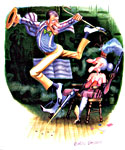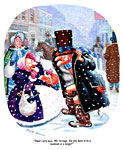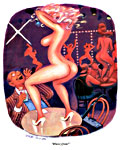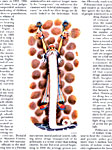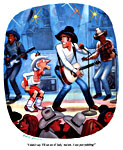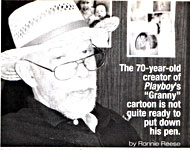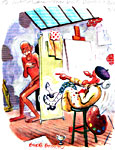BUCK BROWN
AND HIS INSATIABLE GRANDMOTHER
One of
Playboy’s Original Line-up of Cartooners in Color
Buck Brown, one of Playboy’s contract cartoonists for almost 45 years, died last
summer on Monday, July 2, of complications after suffering a stroke on June 23.
He was 71. Respectful obituaries appeared in the Chicago Sun-Times, his hometown newspaper, and elsewhere, including
the International Herald Tribune, which suggested his status in the culture as well as at the magazine. Playboy, which goes to bed months before
its publication date, wasn’t able to recognize Brown’s absence until its October
issue. Brown
was an important cartoonist because he was a good cartoonist. He drew funny,
sophisticated cartoons. He was in full command of his medium, whether in black
and white or in color. And he invented a memorable character, the laughably
lascivious Granny, who, like all uniquely original creations, outlives her
creator. When Reese’s article appeared, Brown was still
alive. He was in the twilight of a long career and a little frustrated, puzzled
by the fading light. “He had outlasted the glory days of the magazine,” Reese
wrote, “in which his contributions were an important ingredient in the
successful Playboy formula. As
creator of the iconic Granny cartoons—panels that featured a sexually
insatiable, long-nosed elderly sprite—Brown kept a couple of generations of Playboy readers laughing out loud. ...
While Granny still makes sporadic appearances in the magazine, she has, by and
large, been retired.” And so has Brown, Reese said, and not altogether
voluntarily. “Slowed by a heart attack and complications from diabetes and
cataracts, he continues to paint and draw. He loves his work, but is no longer
earning a living at it, which upsets him. He’s used to making money. ... This
presents a challenge,” Reese continued, “partly because of his health but also
because of his industry. ... Brown realizes that Playboy is currently chasing a younger audience and that his brand
of funny isn’t an easy sell to the ‘
And
so, maybe, is Playboy. “Though Playboy still boasts a circulation of
about 3 million and Hef, at 80, still cavorts in his pajamas with women young
enough to be his great-granddaughters, the magazine has lots its edge,” Reese
went on. “As Playboy started its
decline, Brown’s career also lost steam.” In his best years, his cartoons
appeared not only in Playboy but in Ebony, Jet, Dollars and Sense, Esquire, The
New Yorker, and the like, plus the Chicago Sun-Times and an occasional book. But over the years, Reese
observed, “magazines were using fewer and fewer illustrations. Consolidation in
book publishing meant fewer opportunities for artists. Playboy became Brown’s lone source of regular employment, and even
it was becoming indifferent. Granny, it seems, had worn out her welcome.”
He
wasn’t “blistering with rage” about his unaccustomed and unwelcomed retirement,
Reese noted; “he’s stewing with solemn, old-man disgust. Still, Brown is proud
of his run at Playboy. ‘Forty-five
years on any corner is good,’ he reasons.”
Brown
wasn’t angry, but Reese was. He felt the magazine was slighting one of its
mainstays, ignoring Brown in its 50th anniversary commemorations and
not publishing his cartoons. Later, after the publication of Who-Ville, he learned why. “In the end,”
he wrote me, “I found out from Playboy that the reason Buck’s assignments began to diminish was because his line was
‘off’ in the time following his cataract surgery. He didn’t notice it, but the
magazine did.”
Before
sending me the article for posting here, Reese revised it slightly, leaving out
what he called “the animosity.” I didn’t see as much animosity in it as he did.
And I thought the material that I’ve culled from the original piece in the
foregoing paragraphs completed the portrait of Buck Brown. His vitality may
have been fading, but he remained a proud and accomplished cartoonist with a degree
in fine arts and a passion, still, for painting. In his acceptance of his fate
with Playboy, Brown shows a gentle
forbearance that maintains a great and enviable dignity, as a man and as a
cartoonist.
Now,
here’s Reese’s article; after which, we’ll have a Granny Gallery and then a few
words about Ronnie Reese. Stay ’tooned.
Keeping Granny Alive
Robert “Buck” Brown is sitting in the living room of
his comfortable south suburban Chicago home, poring over photos of old
acquaintances — centerfold models in Playboy magazine. Most of the women in the decades-old magazines no longer resemble the
images preserved on these pages. Some of them are no longer alive.
“I
met her, and she’s dead. And I met her, and she’s dead,” Brown reminisces, as
he flips through the glossy magazines, a tinge of melancholy coloring his
voice.
At
70, Brown, who for more than 40 years was a cartoonist at Playboy, has outlasted many of the Playmates he met over the years,
a time in which his contributions were an important ingredient in the
successful Playboy formula. As
originator of the iconic Granny cartoons — panels that featured a sexually
insatiable, long-nosed elderly sprite — he kept generations of readers laughing
out loud. Brown has drawn children, cops, pimps, prostitutes, John F. Kennedy
and Truman Capote — both JFK and Capote in the same panel — but Granny is the
greatest part of his legacy, and perhaps more well-known than her creator.
Longtime Playboy Cartoon Editor
Michelle Urry, who worked with Brown from the early 1970s until her death in
October of 2006, once wrote about his seminal figure as a “little old lady
complete with saggy appendages and a bun that was absolutely nothing like him.
People constantly commented on her as a character that provided comic relief for
them.”
“In
order to succeed as a comedian or cartoonist or what have you,” says Brown, who
is long-limbed and ingratiating, and bears a grizzled resemblance to “60
Minutes” correspondent Ed Bradley, “you have to have an audience, and you have
to be able to appeal to that audience. If they don’t look at it and laugh, then
what are you drawing for?”
It
was such an understanding of the nature of his craft that provided motivation
for the impish innocence that Brown and cartooning peers such as Eldon Dedini, Doug Sneyd and Erich Sokol perfected for five decades
at Playboy. Their illustrations have
always been an integral part of the magazine, something which evolved out of
the cartoon traditions of Esquire and The New Yorker.
It’s
an old cliché to hear people say, “I only read Playboy for the articles,” but there are some that do. Others find
the pictorials more to their libidinous satisfaction. Yet for a select few, the
single-panel comics are the appeal. A talented cartoonist contributes more to a
magazine’s overall tone and voice than is typically realized.
At Playboy, Brown has always known his
role, and he also knows there is one area in which he has to figuratively draw
the line. His entire life has been dictated by what he does for a living, but,
as he is often quick to point out, “I’m still just a regular dude. People see
me as a Playboy cartoonist,” Brown
explains, “so they presume I’m some big freak or something, but that’s only in
terms of coming up with the ideas. And I refuse to pose in the nude.”
*****
Buck Brown has been a freelance cartoonist for his
entire career. He hasn’t had a “real” job since the 1960s, when he drove a bus
for the Chicago Transit Authority. “When I met him early on in his career,”
Urry wrote to The Star newspaper of
When
he introduced her to Playboy readers
in 1966, the magazine was in its 13th year of existence. The repression,
conventionality and conformism of the ’50s was gone, yet it was still an
anomaly to see a hunched, white-haired old lady in constant heat, lusting after
any man who would have her, as well as those who clearly wouldn’t. Granny loved
to ball, and was a perfect fit for the Sexual Revolution.
“The
initial popularity was because of the outlandishness of this wizened old woman,
with her sagging breasts, being so sexually voracious and eager,” says R.C.
Harvey, an author and cartooning scholar. “That fit into the general Playboy philosophy, which is that women
enjoy sex as much as men do. It was a way of comedically emphasizing that
aspect of it.”
“I
thought the Granny character had a real sweetness to her,” says Gahan Wilson, a fellow Illinoisan and
longtime Playboy illustrator.
Granny
was a star. And even though few casual observers knew his name, Brown was a
star by extension.
“My
mother was such a fan,” says Kerig Pope, who served as managing art director at Playboy for 36 years and worked
closely with Brown on a handful of illustrations and other pieces. “I told him
that and he did a Granny cartoon just for her. She absolutely loved it.”
Art
enthusiasts knew Buck Brown’s name and his technique, though maybe not his
face. Once, while entering a cab in
“What
are you, an artist?” the driver asked.
“Not
really. I’m a cartoonist.”
“You
mean like Buck Brown?”
Brown
could hardly contain the excitement of being “recognized.” “I knew then,” he
recalls, “how Jimmy Stewart must have felt in ‘It’s a Wonderful Life.’”
And
no group appreciated Brown’s work more than his contemporaries. “Buck’s got
that ability to put across what he’s doing and what his intentions are,” says LeRoy Neiman, one of the most popular
American painters of the 20th century and a Playboy contributor for more than 50 years. “That’s a very special thing. He knows his
craft, he knows his art, and he knows how to get his point across. He’s a
special one.”
What
makes Brown’s accomplishments even more special is that he is an
African-American cartoonist who made his mark with work that was not primarily
race-based. Yet he was still able to address racial issues, “in a way that no
one else was doing,” according to Urry, “[with] gentle but sophisticated takes
about the protest movement and civil rights issues of our time.”
“I
could always handle civil rights,” says Brown. “I am civil rights, but it
probably helped me because Playboy couldn’t see my face. It was a long time before anyone even knew I was black.”
“The
idea that Buck was a black man, most people didn’t realize that,” Pope
explains. “I think that was the greatest thing in his favor, that they didn’t
put that together. Nobody published it and made it a big issue. It was just
that people liked the cartoons and thought they were funny, but it was
definitely an achievement.”
*****
Brown was born on
He
noticed a transfer student drawing cartoons one day in elementary school, and
realized that, at the same age, he could also become an artist. Brown soon took
up cartooning as a personal pastime, eventually standing out among his
classmates and establishing himself as the only member of his immediate family
with any discernible creative ability. He was in high school when he saw Playboy for the first time in a local
bookstore.
Launched
in 1953 by Hugh Hefner, a former promotional copywriter for Esquire, Playboy immediately became the
model for post-World War II perceptions of American sexuality. With its
tasteful nude pictures of the quintessential girls next door, and high-brow
fiction and literary journalism, the magazine offered a guide to an imaginary
lifestyle that few men could actually afford to live. Still, its appeal was
undeniable.
“I
would go in [the bookstore] and look at the girlie books and stuff,” Brown
recalls, “and this one stood out so distinctly. I said, ‘Wow ... I’m going to
have to start stealing this!’”
After
graduating from high school, unsure about whether he could meet the rigors of
college course work, he entered the Air Force and began working as a hydraulic
mechanic. While in the service, Brown drafted caricatures of some of the
lower-ranking members of his company, like the squad drunk waking up with a
hangover and putting his shirt on his legs and his pants on his arms. “I was
gaining confidence and really getting it then,” he recalls. “I was starting to
understand the power of the pen.”
One
afternoon, he got a large sheet of butcher paper and drew a caricature of
everyone in the squadron in individual states of absurdity. “All the guys came
in, got the drawing and put it up on the bulletin board,” says Brown. “I didn’t
want it up there, because I knew the chance I was taking drawing white folks
back then. You have to realize that this is the mid-fifties. Martin Luther King
hadn’t marched anywhere yet. And sure enough, a couple of days later, someone
came in and said, ‘Brown, the CO [commanding officer] wants to see you.’”
“Drawing
white folks,” was the young artist’s initial worry, but ironically, his CO just
wanted to know why he had been left out of all the fun. “He noticed I didn’t
put him in there,” says Brown. “I told him I was just a cartoonist and I was
fully aware of his rank. Basically, I was trying to avoid jail. He told me to
take it back home, put him in it, and nothing would be said about it.”
When
Brown returned home from the service in 1958, he began driving CTA buses while
attending junior college in the area. He took general classes before enrolling
at the
“They
told me to send the stuff in on 8½-by-11 bond paper, with a self-addressed,
stamped envelope. I had seven good ideas, but eight is a much smoother number,
so I came up with this idea about a little boy standing in the corner holding a
trumpet. His mother tells his father, ‘No, he isn’t being punished, he’s just
imitating Miles Davis.’” The piece was in reference to
“They
sent back the others and told me they were holding that one for further
consideration. I come home a couple of weeks later, and here’s a Playboy envelope with that bunny logo on
it. I take it upstairs and open it, and it says, ‘Dear Mr. Brown, please give
us a black-and-white finish on the following cartoon.’ Man, I went through the
roof!”
Brown
continued coming up with ideas and submitting his work, selling one or two
pieces at a time, sometimes three. “My last year on the bus was 1965,” he says.
“I’d been doing pretty good submitting sporadically; what would happen if I
just sat down and ground them out on a regular basis?”
He
began sending out six to eight ideas per week. The second time Playboy responded, they bought close to
15 pieces, some to be done in black-and-white, some to do in color if he chose,
and some whose gags he would be paid for but the drawing would be assigned to
other artists.
“Hell,
I was a student,” Brown remembered, and with the magazine paying $500 for
black-and-white sketches and $1,000 for color, “anything I didn’t know about
color, I could damn sure learn in a hurry.”
At
the time, Brown was dating a beautiful, fair-skinned co-ed, a
Once
his workload picked up at Playboy, Brown called Mary Ellen and told her he would finally be able to buy her an
engagement ring. She preferred that the two just get married. “I was okay with
it,” he says, “as long as we had a plan — no kids [yet].”
They
married in December of 1965. A few months later, just prior to graduation,
Brown made his first trip to the Playboy mansion.
“They
invited me up there for lunch,” he said. “This is when it was just north of
Division on
Brown
intended to a get a job in advertising after graduation and draw on the side,
but he was persuaded by the magazine to stick with cartooning. He signed on as
a regular contributor and became a member of an elite fraternity of Playboy cartoonists — including Phil Interlandi (“a master of
composition”) and Plastic Man comic creator Jack Cole — selling 20 to 30 cartoons every one or two months.
“Things
worked out pretty good for me,” says Brown. “I didn’t ever think of building a
career with it.” He was also drawing “Sonny and Honey” for Ebony magazine’s children’s offshoot Ebony Jr.!, and doing illustrations for
By
this time, Brown was also a father of two and had his hands full as a
stay-at-home dad. While his wife worked in data processing at Johnson &
Johnson baby products, and later at Panduit Corporation in nearby
“Our
children never came home to an empty house,” says Mary Ellen. “Even when he was
in
Throughout
the ’70s, Playboy flourished,
reaching its circulation zenith of close to seven million in 1975. Granny was
along for the magazine’s success. “Somebody introduced me to a Presbyterian
minister that knew who Granny was,” Brown says in amazement. “There are people
who don’t even read Playboy that know
who she is.”
“It
was so wonderfully shocking back then, this dirty old lady,” says author and
former Playboy articles editor, David
Standish, who would drift in and out of Urry’s 9th floor office in
Brown
liked Granny because she was effective in any setting, as opposed to the
classic buxom, hourglass-shaped female figurine. Sex is sex, but the references
were worlds apart. The inspiration for the character came to him during his
years as a city bus driver. As he would open the doors for new passengers,
Brown was occasionally met by well-intentioned, elderly women asking if he
“went down,” or “Do you go all the way?” He began carrying a sketch book to
document the moments, and the rest of his story — and Granny — became etched in Playboy history.
Starting
out, “I was just trying to be hip,” Brown explains. “I didn’t figure [Playboy] would let me handle any risqué
stuff yet, so I just thought I’d be cute.” Once the work became a steady source
of income, “that’s when the dirty stuff started flowing,” he admits, but he
remained the consummate family man. “I was never one to socialize like that,”
he says. “When my family would go to bed, I would have one more Jack Daniels
and go up myself.”
For
Brown, being a part of Playboy tradition didn’t mean living the life of a playboy. All he wanted to be was a
cartoonist. “I would have drawn for free,” he says. “You could paste my stuff
to my back and I’d jump off of the
But
cartooning is a visual medium, and when it comes to sight humor, it can be
challenging to gauge what is visually going to make someone laugh. The answer
is in the storytelling. Drawing a chuckle has always been Brown’s strong suit,
which he accomplished through the stories told in his panels — and not just
tales of sly, sexual hijinks, but also reflections on cultural issues, which he
did more so than other artists at Playboy.
“When
you draw a cartoon addressing a serious issue,” Standish explains, “you take a
bit of the pressure off of the content. It doesn’t seem as if you’re getting
beat over the head, but the point is still being made. Brown is wonderful at
that.”
And
as Brown wryly shares the fictional title of his autobiography — “How I
Overcame the Obstacles Confronting Me as a Black Man in
“Buck
should be honored because he’s a major survivor out there,” says Neiman, a
former student and instructor at the School of the Art Institute in
*****
“Oh, that’s my sweetie,” Brown says as he hears the
garage door open, signaling Mary Ellen’s return. Their tidy house is filled
with reminders of their six grandchildren: Mother Goose books share space on
the wood and glass coffee table with his wife’s Sudoku puzzles and a copy of O, The Oprah Magazine. Family pictures
and paintings adorn the walls, including one piece done by Brown in 1993 titled
“Journey of Life,” in which a contemporary, five-member black family walks a
circular rut around a grassy mound.
Mary
Ellen Brown, 63, is her husband’s biggest fan. The two have been married for 40
years and have the easy give-and-take of a couple that has been together for a
lifetime.
“Buck,
you need to eat something now,” Mary Ellen insists.
“My
wife stays in my ass,” he laments. “But if it wasn’t for her, I’d be pushing up
daisies somewhere.”
Brown
suffered a heart attack in 1996 and a stroke in 2000, both complications from
diabetes. He awoke one morning in 2005 to blurred vision in a left eye filled
entirely with blood, leading to cataract surgery later that year. He attends
physical therapy and diabetes education classes multiple times a week. “Every
time I turn around,” says Brown, “something else has gone clunkety.”
Mary
Ellen has planned for her husband’s life after Playboy. The two are a true right-brain, left-brain pairing — he is
the creative half, while she focuses on facts and figures. “We’re opposites in
that way,” says Mary Ellen, a mathematics major at the
Brown
spends his days painting and keeping up with health classes and doctor’s
appointments. An avid golfer for 40 years, he plans to get back out on the
links as soon as doctors give him the green light. He also has his wife’s
agenda to stick to.
“She’ll
be out and call home and tell me not to leave because we’re going to do this or
that,” he says. “She retired, and then she wanted me to retire with her.”
He
rises from the couch, hesitates and trembles slightly before walking. A second
or two passes before he can even take a step. Brown does still paint, although
his current work is more reflective of classic and contemporary themes of
everyday African-American life, and not the sophisticated bathroom-wall humor
put forth in his work for Playboy. Behind him are the days of drawing cartoons of God asking Adam to pull his
finger on the ceiling of the Sistine Chapel, or Granny complaining to an old
companion that, “You never sock it to me anymore.”
“I
have a few paintings I want to get back to,” says Brown, “if the doctors will
let me go.” Medical obligations interfere with a schedule that used to allow
him to paint long into the night and sleep during the day. “Getting up and
getting ready and going to see these doctors and stuff like that — why bother?”
Mary
Ellen feels that if he manages his diabetes, he could develop a regular
painting routine.
“The
fewer doctors he has to see, the more time he has for his work,” she explains.
“That’s what this [diabetes] training is all about, for him to know what he has
to do to stay healthy, then for him to do it. Then, he can cut out a lot of
doctors.”
Brown’s
health problems might just be a temporary setback, but frustration and
intransigence won’t let him see it. Fortunately, his wife does. “Buck’s always
said he’s never going to retire. He’ll always be an artist.”
A Granny Gallery
Here’s a short helping of Buck Brown’s work from the pages of Playboy and elsewhere. The first picture is a self-caricature Brown did for collector Mark Cohen in which the cartoonist is doing a “buck” and Granny is doing the “winging” with a red-hot pistol, calling the tune, you might say. (This drawing is taken from that book I did with Mark, A Gallery of Rogues: Cartoonists’ Self-caricatures, about which you can learn more by clicking here.) Then come some Playboy cartoons, including a couple Grannys and an illustration (old guy chained to the wall), followed by a copy of a halftone photo of Brown at the age of 70 that appeared in Who-Ville; and then, the final picture, another Brown self-caricature, this one done for Mark Cohen’s “nude self-caricatures by cartoonists” project (see Opus 213 for details about this inspired nonsense).
As a concluding example of Reese’s journalism, here’s
an autobiographical squib I asked him to supply:
Ronnie
Reese is a native of
Undaunted,
Reese continues to make somewhat of a career in journalism as a regular
freelance contributor to Wax Poetics and Stop Smiling magazines, in addition to
alternative weeklies in the San Francisco-Oakland Bay area, the Audiversity.com
audio blog, and other publications that seem to sprout daily. He is also a
member of the National Association of Black Journalists and an alumnus of the
Academy for Alternative Journalism at the Northwestern University Medill School
of Journalism and Integrated Marketing Communications.
Despite
still having to work the much-maligned corporate day job, Reese has found that
writing is—and will always be—his true passion. But the greatest lesson for him
came not from his co-worker at the Tribune,
but from words spoken by actress Lily Tomlin, who is also no stranger to the
“Nine to Five” way of living. “I always wanted to be somebody, but now I
realize I should have been more specific.”
Reese
can be reached at reeseronnieL@hotmail.com
|
|||||||||||
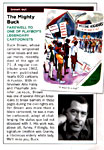
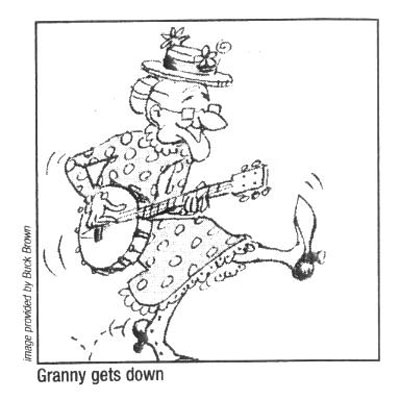 But Brown was also an important cartoonist
historically: he was one of the first African-American cartoonists to achieve
national circulation in mainstream media. His first cartoon for Playboy was published in March 1962,
putting him in equally important company: syndicated comic strip cartoonists Morrie Turner (Wee Pals), Brumsic Brandon
Jr. (Luther) and Ted Shearer (Quincy), all African-Americans, made it into mainstream newspapers
during the same decade as the civil rights movement was gathering
momentum—Turner in 1965, Brandon in 1968, and Shearer in 1970. But Brown was
different: his cartoons didn’t usually feature any racial minorities and they
weren’t usually about race. Like the magazine cartoons of E. Sims Campbell, another African-American gag-panel cartooner who
debuted in Esquire’s first issue in
the fall of 1933, Brown’s cartoons were about sex, usually, and sometimes about
some of the other “entertainments for men,” Playboy’s self-proclaimed turf. Golf, for instance: Brown was an avid golfer. Turner,
Brandon, and Shearer all dealt the race card, so to speak; Brown didn’t. Not as
a general rule. He sometimes turned to racial issues, as Playboy’s obituary notice (above) indicates. And when he did, said
Michelle Urry, the magazine’s long-time cartoon editor, “he rendered the most
incisive comments on race relations in
But Brown was also an important cartoonist
historically: he was one of the first African-American cartoonists to achieve
national circulation in mainstream media. His first cartoon for Playboy was published in March 1962,
putting him in equally important company: syndicated comic strip cartoonists Morrie Turner (Wee Pals), Brumsic Brandon
Jr. (Luther) and Ted Shearer (Quincy), all African-Americans, made it into mainstream newspapers
during the same decade as the civil rights movement was gathering
momentum—Turner in 1965, Brandon in 1968, and Shearer in 1970. But Brown was
different: his cartoons didn’t usually feature any racial minorities and they
weren’t usually about race. Like the magazine cartoons of E. Sims Campbell, another African-American gag-panel cartooner who
debuted in Esquire’s first issue in
the fall of 1933, Brown’s cartoons were about sex, usually, and sometimes about
some of the other “entertainments for men,” Playboy’s self-proclaimed turf. Golf, for instance: Brown was an avid golfer. Turner,
Brandon, and Shearer all dealt the race card, so to speak; Brown didn’t. Not as
a general rule. He sometimes turned to racial issues, as Playboy’s obituary notice (above) indicates. And when he did, said
Michelle Urry, the magazine’s long-time cartoon editor, “he rendered the most
incisive comments on race relations in 